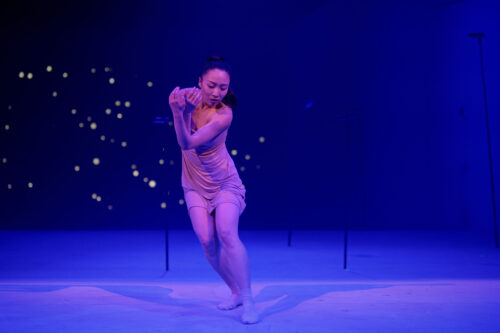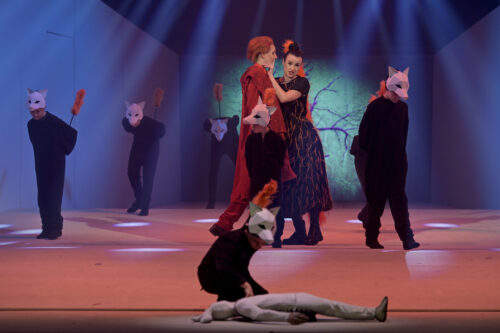 Czech Republic Janáček, The Cunning Little Vixen: Soloists, Chorus, Ballet and Orchestra of the National Moravian-Silesian Theatre / Adam Sedlický (conductor). Antonin Dvořák Theatre, Ostrava, 21.3.2025. (GT)
Czech Republic Janáček, The Cunning Little Vixen: Soloists, Chorus, Ballet and Orchestra of the National Moravian-Silesian Theatre / Adam Sedlický (conductor). Antonin Dvořák Theatre, Ostrava, 21.3.2025. (GT)

Based on a cartoon story by Rudolph Tĕsnohlídek in a local newspaper, Janáček’s improbable opera about the love of a vixen and a fox was stirred by his love of nature and, most of all, by the forests near his home of Brno in Moravia. Nevertheless, the challenging scenes of wildlife and animals for opera was masterfully realised by the composer writing his own libretto – creating a work of great sensitivity and true to his love of nature. Janáček’s opera has often perplexed audiences since the 1924 premiere, sometimes it is perceived as a comedy, or more likely a satire on society and a critique of people’s inhumanity to animals. In my opinion, it is the warmth and vibrancy of Janáček’s orchestration and singing that allow one to judge it better as an opera evincing the harmony of humankind and the animal world.
The city of Ostrava first put on The Cunning Little Vixen in Jaroslav Vogel’s production in 1936 and was seen during two seasons. Since which there have been five productions in the Moravian city, the last one in 1994. This staging by the Israeli choreographer Itzik Galili premiered on 6 October 2024 and was successfully performed at the 2024 Janáček Festival in Brno. Galili has worked in both Europe and America in ballet and contemporary dance: his operatic work has been choreography for Tcherniakov’s Prince Igor at New York’s Metropolitan Opera, and in Tel Aviv he both staged and choreographed Orpheus et Eurydice and he has been nominated for some notable awards.
The staging throughout comprised a tunnel-like box with a rear ingress allowing entry and exit for the characters – it also facilitated a visual projection of images, allowing the swiftly changing projected colours of reds and greens shifting to blacks and yellows to create sensational effects. In Act I, the entry of the young Vixen, the Blue Dragonfly, the Badger, the Hedgehog, and the Squirrels gave the impression we were watching a fashion show as each character walked directly towards the audience and took their place on either side, as dancers placed lights as if candles. This was a striking revelatory statement by Galili in presenting this opera with an emphasis on visual spectacle with dance enhancing the musical narrative.
The forest animals and wildlife performed a charmingly choreographed series of dances during the beautifully scored orchestral introduction and this was illustrated by quickly transforming colours. In this first scene, we see the capture of the young Vixen by the Forester, and as the wildlife play and dance, the now transformed grown-up Vixen gains her freedom tearing the rope and then attacking the rooster and threatening the chickens. In a scene which was both funny and startling – a coup de théâtre in fact – the poor terrorised clucking chickens in their red and white costumes were ushered away safely.
The Act II bar scene was portrayed with great subtlety as the Parson, Forester and Schoolmaster lust after the attractive village girl Terinka, and as the trio of drinkers get steadily more tipsy the bar table mysteriously moved across the stage. We saw another visually entertaining episode as the Parson of Jan Šťáva rode away shakily on his bicycle illuminated by a neon-lit crucifix. Back in the forest, the Vixen meets up with the Fox and falling in love take up domicile in the Badger’s lair.
Act III opens with a movingly emotive scene as the Vixen and Fox reminisce about their happiness and their offspring. Quickly, the domestic happiness transforms as the Forester shoots, by mistake, the Vixen. There followed a stunningly performed orchestral interlude accompanying the solo dance by Yu Matsumoto portraying the spirit of the Vixen. Another magnificently choreographed scene was the apparition of the Fox by Gwendolin Nagy in her striking red and black costume. Finally, the Gamekeeper, in despair after the wedding of his rival to Terinka, reflects on his life in the forest, and with the wildlife surrounding him, the opera closes peacefully in an extraordinary scene of man’s harmony with nature.
Of the principal characters, the bright lyrical soprano of the Vixen of Lada Bočková was magnificent in her lucid characterisation of sexual awakening, while her lover, the Fox of Anna Nitrová, with her creamy and sexy mezzo-soprano controlled many of their scenes with her forceful sensuality. The beautifully intertwined vocal performances of the Vixen and the Fox shaped the musical centre of the whole evening. Of the secondary characters, the most outstanding was Martin Gurbaľ’s Gamekeeper in his characterful interpretation and dusky bass voice. The Schoolmaster and Mosquito of Martin Javorský’s vibrant tenor was distinctive, especially in the bar scene. A striking characterisation too was the Innkeeper, Mr Pásek by Erik Ondruš in his bright lyric tenor. The magnificent darkly toned bass of Jan Šťáva was rather under-used in this opera, yet he also performed remarkably in the scene where he has a mime role as the Badger belligerently threatens the Vixen. The other contribution to the success of the show was by the children’s choir in both acting and singing, expressly in the scene of the chickens being led away in Act I and prevented from being killed by the Vixen. The chorus was excellent and another great success for this company’s musical talents admirably directed by Jurj Galatenko.

The director’s projections of colour and fluctuating action created remarkably powerful imagery in the evocation of nature. Galili’s production was ably assisted by Elizabeth Gibiat and Duilio Ingraffia and Ostrava’s own dramatist Juraj Bajús. Simona Rybakova gave the performers striking and vivid multi-coloured costumes, especially for the children dressed as chickens and fox cubs, all of whom were attired in different colours creating eye-catching visual splendour. There was an echo with the avant-garde costume designs of the revolutionary Ballet Russes over a century ago, most notably Alexandre Benois and Leon Bakst. Daniel Dvořák’s scenery was minimalist and superbly effective in portraying the forest and the intimate decor of the tavern and enhancing the narrative and choreography. In the extended orchestral prelude of the opening scene, the orchestra showed outstanding virtuosity – the score has over forty minutes of purely orchestral music. The visual images projected on the stage and the orchestral playing accompanying the wildlife dancing were a continual pleasure to the eye and ear.
The orchestra, led by the first violin Jan Šošola, evinced all the richness of Janáček’s score, most notably the Moravian folk rhythms and unique tonality associated with the sčasovka, or the composer’s brief harmonic motifs. A highlight was the beautifully expressed flute solos from Michaela Blažková (four flutes were employed), the bassoon of Petr Bubanec, Ondřej Janča’s clarinet and the oboe of Jana Poláškova, abetted by the delightful harmonies of Soňa Bradáčová’s harp and of the brass group. The musicians were on great form throughout under the masterly direction of Adam Sedlický – whether accompanying the singing or the dancing in the orchestral interludes – the conductor injected a marvellous degree of musical colour, making this magical opera come to life. This innovative and often revelatory production was a beautiful evocation of our affinity with nature and brought out all the harmonies of Janáček’s music.
Gregor Tassie
Production:
Music director – Marek Šedivý
Stage, Lighting and Choreography director – Itzik Galili
Set designer – Daniel Dvořák
Costume designer – Simona Rybáková
Chorus master – Jurij Galatenko
Dramaturg – Juraj Bajús
Cast:
Gamekeeper – Martin Gurbaľ
Gamekeeper’s wife / Owl – Jana Horáková Levicová
Schoolmaster / Mosquito – Martin Javorský
Parson / Badger – Jan Šťáva
Harašta – Daniel Kfelíř
Pásek – Erik Ondruš
Mrs Pásková / Cock / Jay – Miroslava Časarová
Pepík – Ondřej Borák
Frantík – Filip Škandera
Young Vixen (Bystrouška) – Sára Bernatíková
Vixen (Bystrouška) – Lada Bočková
Fox – Anna Nitrová
Cricket – Ivona Dominiková
Grasshopper – Felicie Schmidtová
Young Frog – Roman Patrik Baros
Lapák / Woodpecker – Šárka Hrbáčková
Chocholka – Magdaléna Rovenská
Ballet:
Apparition of the Vixen – Yu Matsumoto
Apparition of the Fox – Gwendolin Nagy
Ladybug – Teodora Martinez
Lady Stork- Dorottya Fanni Lengyel
Stork – Maxwell Davies
Squirrel – Viola Izzo
Owls – Viola Izzo, Hannah Lukey, Maria Carla Ognisanto
Blue Dragonflies – Leonardo Baghin, Francesco Fasano, Sachiya Takata, Patryk Zamojski
Old Butterfly – Michal Bublík
Hare – Simone Giroletti
Hedgehog – Mark Griffiths
